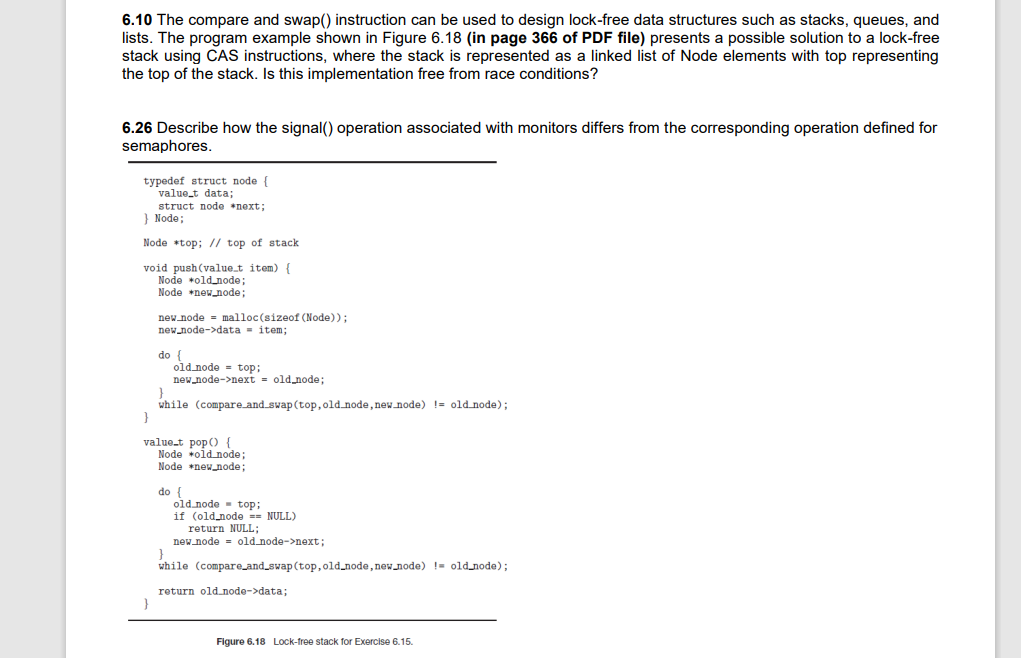6.10 The compare and swap() instruction can be used to design lock-free data structures such as stacks, queues, and lists. The program example shown in Figure 6.18 (in page 366 of PDF file) presents a possible solution to a lock-free stack using CAS instructions, where the stack is represented as a linked list of Node elements with top representing the top of the stack. Is this implementation free from race conditions? 6.26 Describe how the signal() operation associated with monitors differs from the corresponding operation defined for semaphores. typedef struct node { valuet data; struct node •next; } Node; Node top; // top of stack void push(value.t item) { Node *old node; Node newnode; nev node = malloc(sizeof (Node)); nev node->data - item; do { old node = top; new node->next = old_node; uhile (compare and svap(top,old.node,nev.node) != old.node); valuet pop() { Node old node; Node *new_node; do { old.node - top; if (old node == NULL) return NULL; new node = old node->next; while (compare and svap(top,old_node,nev_node) != old node); return old.node->data;
6.10 The compare and swap() instruction can be used to design lock-free data structures such as stacks, queues, and lists. The program example shown in Figure 6.18 (in page 366 of PDF file) presents a possible solution to a lock-free stack using CAS instructions, where the stack is represented as a linked list of Node elements with top representing the top of the stack. Is this implementation free from race conditions? 6.26 Describe how the signal() operation associated with monitors differs from the corresponding operation defined for semaphores. typedef struct node { valuet data; struct node •next; } Node; Node top; // top of stack void push(value.t item) { Node *old node; Node newnode; nev node = malloc(sizeof (Node)); nev node->data - item; do { old node = top; new node->next = old_node; uhile (compare and svap(top,old.node,nev.node) != old.node); valuet pop() { Node old node; Node *new_node; do { old.node - top; if (old node == NULL) return NULL; new node = old node->next; while (compare and svap(top,old_node,nev_node) != old node); return old.node->data;
Computer Networking: A Top-Down Approach (7th Edition)
7th Edition
ISBN:9780133594140
Author:James Kurose, Keith Ross
Publisher:James Kurose, Keith Ross
Chapter1: Computer Networks And The Internet
Section: Chapter Questions
Problem R1RQ: What is the difference between a host and an end system? List several different types of end...
Related questions
Question
How can I do this? Can u show step-by-step for me?

Transcribed Image Text:6.10 The compare and swap() instruction can be used to design lock-free data structures such as stacks, queues, and
lists. The program example shown in Figure 6.18 (in page 366 of PDF file) presents a possible solution to a lock-free
stack using CAS instructions, where the stack is represented as a linked list of Node elements with top representing
the top of the stack. Is this implementation free from race conditions?
6.26 Describe how the signal() operation associated with monitors differs from the corresponding operation defined for
semaphores.
typedef struct node {
value_t data;
struct node next;
} Node;
Node *top; // top of stack
void push(value.t item) {
Node +old node;
Node +new node;
new node = malloc(sizeof (Node));
new node->data = item;
do {
old node = top;
new node->next = old node;
while (compare and_swap (top, old.node, new node) != old node);
}
value.t pop() {
Node +old node;
Node new_node;
do {
old node - top;
if (old node == NULL)
return NULL;
new node = old node->next;
while (compare_and_swap (top,old_node, new node) != old node);
return old node->data;
Figure 6.18 Lock-free stack for Exercise 6.15.
Expert Solution
This question has been solved!
Explore an expertly crafted, step-by-step solution for a thorough understanding of key concepts.
This is a popular solution!
Trending now
This is a popular solution!
Step by step
Solved in 4 steps with 1 images

Recommended textbooks for you

Computer Networking: A Top-Down Approach (7th Edi…
Computer Engineering
ISBN:
9780133594140
Author:
James Kurose, Keith Ross
Publisher:
PEARSON

Computer Organization and Design MIPS Edition, Fi…
Computer Engineering
ISBN:
9780124077263
Author:
David A. Patterson, John L. Hennessy
Publisher:
Elsevier Science

Network+ Guide to Networks (MindTap Course List)
Computer Engineering
ISBN:
9781337569330
Author:
Jill West, Tamara Dean, Jean Andrews
Publisher:
Cengage Learning

Computer Networking: A Top-Down Approach (7th Edi…
Computer Engineering
ISBN:
9780133594140
Author:
James Kurose, Keith Ross
Publisher:
PEARSON

Computer Organization and Design MIPS Edition, Fi…
Computer Engineering
ISBN:
9780124077263
Author:
David A. Patterson, John L. Hennessy
Publisher:
Elsevier Science

Network+ Guide to Networks (MindTap Course List)
Computer Engineering
ISBN:
9781337569330
Author:
Jill West, Tamara Dean, Jean Andrews
Publisher:
Cengage Learning

Concepts of Database Management
Computer Engineering
ISBN:
9781337093422
Author:
Joy L. Starks, Philip J. Pratt, Mary Z. Last
Publisher:
Cengage Learning

Prelude to Programming
Computer Engineering
ISBN:
9780133750423
Author:
VENIT, Stewart
Publisher:
Pearson Education

Sc Business Data Communications and Networking, T…
Computer Engineering
ISBN:
9781119368830
Author:
FITZGERALD
Publisher:
WILEY